forum
library
tutorial
contact

Survival Battle
by Lee HochbergNewsHour with Jim Lehrer, December 17, 2003
|
the film forum library tutorial contact |

|
Survival Battleby Lee HochbergNewsHour with Jim Lehrer, December 17, 2003 |
The presence of salmon in the waterways of the Pacific Northwest have been increasing in recent years, but the Bush administration and some scientists disagree over who can take the credit. Lee Hochberg reports that what the president says is a success, others call a fish story.
 LEE HOCHBERG: Salmon runs in Pacific Northwest rivers have been at historic lows for a decade, with several species listed as endangered. Hydropower dams have chewed up millions of fish. Logging operations and irrigation systems have destroyed habitat and diverted water the fish need to survive.
LEE HOCHBERG: Salmon runs in Pacific Northwest rivers have been at historic lows for a decade, with several species listed as endangered. Hydropower dams have chewed up millions of fish. Logging operations and irrigation systems have destroyed habitat and diverted water the fish need to survive.
GALE NORTON, Secretary of the Interior Department: We're here today to celebrate good news on increased salmon runs.
LEE HOCHBERG: But this year has seen an increase in salmon numbers. President Bush and Interior Secretary Gale Norton appeared at a Washington state dam in August to hail what are shaping up as bountiful runs of salmon. And they took credit for them.
A promise for salmon restoration
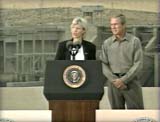 GALE NORTON: When President Bush campaigned for president, he promised the people of the Northwest that his administration would be committed to salmon restoration. He has fulfilled this promise.
GALE NORTON: When President Bush campaigned for president, he promised the people of the Northwest that his administration would be committed to salmon restoration. He has fulfilled this promise.
LEE HOCHBERG: The administration credits new technology in dams and improved hatchery practices, and says it's spending between $600 million and $700 million a year for salmon restoration to meet the requirements of the Endangered Species Act.
But the administration's claims have been challenged by biologists and some editorial page writers. Seattle newspaper columnist Joel Connelly.
JOEL CONNELLY: As a boy, I caught my first salmon when I think I was 8 years old, and I learned then that you have something in this world called "the fish story," where you exaggerate what you've done. I think what we have here is the biggest of all fish stories.
 LEE HOCHBERG: Everyone agrees that salmon numbers are increasing, as at this fish ladder at the Bonneville Dam on the Columbia River.
LEE HOCHBERG: Everyone agrees that salmon numbers are increasing, as at this fish ladder at the Bonneville Dam on the Columbia River.
FISHCOUNTER: That was a pink, a male pink.
LEE HOCHBERG: But biologists credit not the administration but global climate change that has cooled ocean temperatures and improved conditions for salmon. University of Washington climatologist Nathan Mantua says the higher salmon counts may be only temporary.
 NATHAN MANTUA: The next time ocean conditions go bad, populations are likely to crash again. We can't think that the status quo on the landscape is going to be enough to allow these endangered populations to persist over the long haul.
NATHAN MANTUA: The next time ocean conditions go bad, populations are likely to crash again. We can't think that the status quo on the landscape is going to be enough to allow these endangered populations to persist over the long haul.
LEE HOCHBERG: Fishermen netting these Chinook salmon on the Columbia River say the increasing salmon counts are misleading because only a small fraction are high quality wild fish hatched in natural beds on the river. Tribal fisherman Randy Settler says most of his catch are a lesser quality fish, born in hatcheries.
RANDY SETTLER: Sure, there's a lot of fish, but these fish here, these hatchery-origin fish have little commercial value, and most of them are going to be taken in to land fertilizer.
The need for farming irrigation
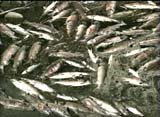 LEE HOCHBERG: In fact, many fishermen and biologists say the government's actions in the past few years have devastated the preferred wild fish in several areas. The state of California, for example, said 33,000 salmon, including endangered species, died last fall because the federal Bureau of Reclamation diverted too much water from the Klamath River. It was the biggest fish kill in California history. The water was to irrigate farmers' fields.
LEE HOCHBERG: In fact, many fishermen and biologists say the government's actions in the past few years have devastated the preferred wild fish in several areas. The state of California, for example, said 33,000 salmon, including endangered species, died last fall because the federal Bureau of Reclamation diverted too much water from the Klamath River. It was the biggest fish kill in California history. The water was to irrigate farmers' fields.
The Klamath system has supplied water to farms along the Oregon California-border for almost a century. But now, with salmon endangered, the government is required to first make sure there's enough water left for the fish. Government biologists say they warned that diverting water from the Klamath last year would kill fish, but were ignored by their supervisors in the Department of Interior.
 KRISTIN BOYLES, Environmental Lawyer: The science that supports the need for the fish to have more water was not just ignored but was absolutely suppressed, was changed.
KRISTIN BOYLES, Environmental Lawyer: The science that supports the need for the fish to have more water was not just ignored but was absolutely suppressed, was changed.
LEE HOCHBERG: Attorney Kristin Boyles represents fishermen and conservationists who've sued the government for violating the Endangered Species Act. She says it was a mystery why the biologists' warnings were ignored.
But an answer may be in a recent report in the Wall Street Journal. The Journal described what happened in 2001, when the government did shut off irrigation water to save salmon in the Klamath and enraged farmers stormed the irrigation gate and set off an angry summer-long protest.
In January of 2002, President Bush visited Oregon, a state he'd barely lost in the presidential election. According to the Journal, his political strategist, Karl Rove, met the next day with Interior Department managers, suggesting they craft a pro-farmer water policy that would solidify Oregon farmers' support for Bush in the 2004 election.
The Journal says Rove "made clear that the administration was siding with agricultural interests." Rove met with the farmers, too. Dan Keppen of the Klamath Water Users Association was there.
 DAN KEPPEN: The main thing he said is, "I want you all to know that, you know, we're setting up this task force. There'll be an announcement made in the next week or two." So he gave us a heads-up and we kind of felt, wow, that was kind of special, you know. We got the inside track. It was just amazing and just heartfelt gratitude. There's no doubt I'm voting for him.
DAN KEPPEN: The main thing he said is, "I want you all to know that, you know, we're setting up this task force. There'll be an announcement made in the next week or two." So he gave us a heads-up and we kind of felt, wow, that was kind of special, you know. We got the inside track. It was just amazing and just heartfelt gratitude. There's no doubt I'm voting for him.
LEE HOCHBERG: Interior Secretary Norton came to Oregon two months later, in March of 2002, to turn the water to the farms back on. Interior says its decision was based on best available science, though it disregarded its own biologists.
It cited an interim report it had solicited from the National Research Council. It concluded that there had been no scientific rationale to justify cutting off the farmers' water in 2001. But as water flowed to farmers again in summer of 2002, the fish kill occurred. They died as they tried to make their way up the now-too-shallow river.
KRISTIN BOYLES: This was a tragedy of just amazing proportions, but the votes Bush needs are in Oregon and are with the farmers.
LEE HOCHBERG: The Bush policy remains popular with farmers, who had suffered when their water was turned off. Ed Bair has just harvested this year's hay crop.
EDWARD BAIR: Certainly I'm thankful that we have water. We brought our crops in this year, so the water policy worked for us.
Reasons behind the large fish kills
LEE HOCHBERG: A final version of the National Research Council report, released a month ago, said the fish kill couldn't be blamed on the diversion of water alone. It said logging, grazing and dam-building imperiled fish habitat and were significant causes of the fish kill. But a just-released study from federal biologists lays blame for it squarely on the diversion of water to farmers.
In a 130-page analysis released November 18, the U.S. Fish and Wildlife Service concludes: "Low river discharges ... did not provide suitable flows ... for salmon."
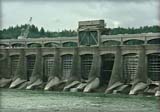 As for the other land management issues brought up by the National Research Council, the administration has been under pressure for policies throughout the Northwest.
As for the other land management issues brought up by the National Research Council, the administration has been under pressure for policies throughout the Northwest.
Nine hydropower dams on the Columbia and Snake rivers in Washington state and Idaho have cut off much of the region's salmon habitat and killed millions of fish in their giant turbines. Some scientists recommend breaching, or punching holes through, four of the dams to improve fish passage. But the president has said that's out of the question.
PRESIDENT GEORGE W. BUSH: We got an energy problem in America, and we don't need to be breaching any dams that are producing electricity. (Applause)
What I said when I ran for president, I said, "Look, we, we're concerned about the fish. We're also concerned about the citizens of Washington state who depend upon the dams for electricity."
LEE HOCHBERG: The administration is exploring technological improvements to the dams. National Marine Fisheries Service Administrator Bob Lohn showed us a $40 million fix to make one dam easier on salmon.
BOB LOHN: We found when they reached the dam, they were milling around and collecting in this area. They sometimes entered the turbines, where there was a mortality rate of 5 to 10 percent. So what we've done is provide a safe channel to reenter the main river.
Other measures at work
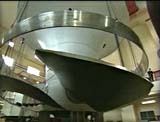 LEE HOCHBERG: Elsewhere at the dam, the government is spending $5 million to retrofit turbine blades so they kill 1 million fewer fish. And Lohn says the administration is funding efforts to help private homeowners restore salmon habitat on streams and lakes along their property.
LEE HOCHBERG: Elsewhere at the dam, the government is spending $5 million to retrofit turbine blades so they kill 1 million fewer fish. And Lohn says the administration is funding efforts to help private homeowners restore salmon habitat on streams and lakes along their property.
But fishermen on the Columbia River say the president's pro-timber policy is itself damaging habitat. They say logging operations like these destroy spawning beds. And they're furious that the administration has just rewritten the Northwest salmon plan.
Drawn up during the Clinton administration, that plan had restricted timber harvests in watersheds on which salmon depend. Conservationists say, under the new plan, salmon habitat in some 60 locations could be sacrificed for timber. Charles Hudson of the Columbia Intertribal Fish Commission, which safeguards the Indian treaty right to salmon:
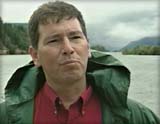 CHARLES HUDSON: You can't cut timber in a watershed and expect stream quality to improve, to have spawning conditions improve. It just doesn't happen.
CHARLES HUDSON: You can't cut timber in a watershed and expect stream quality to improve, to have spawning conditions improve. It just doesn't happen.
LEE HOCHBERG: The government's Bob Lohn says the rewrite was needed to help the timber industry. And while the plan now imperils some salmon, he says it protects the species as a whole.
BOB LOHN: The purpose of these revisions, obviously, is to allow timber harvests to move forward, even though in one area there might be a loss of one or two spawning opportunities for salmon. There might be some additional sediment. Over the long term we would be making sure that the whole watershed was managed as a healthy place for salmon.
LEE HOCHBERG: The Bush administration has asked for an additional $100 million to implement recovery measures for endangered salmon. Congress is debating that additional funding.
learn more on topics covered in the film
see the video
read the script
learn the songs
discussion forum
